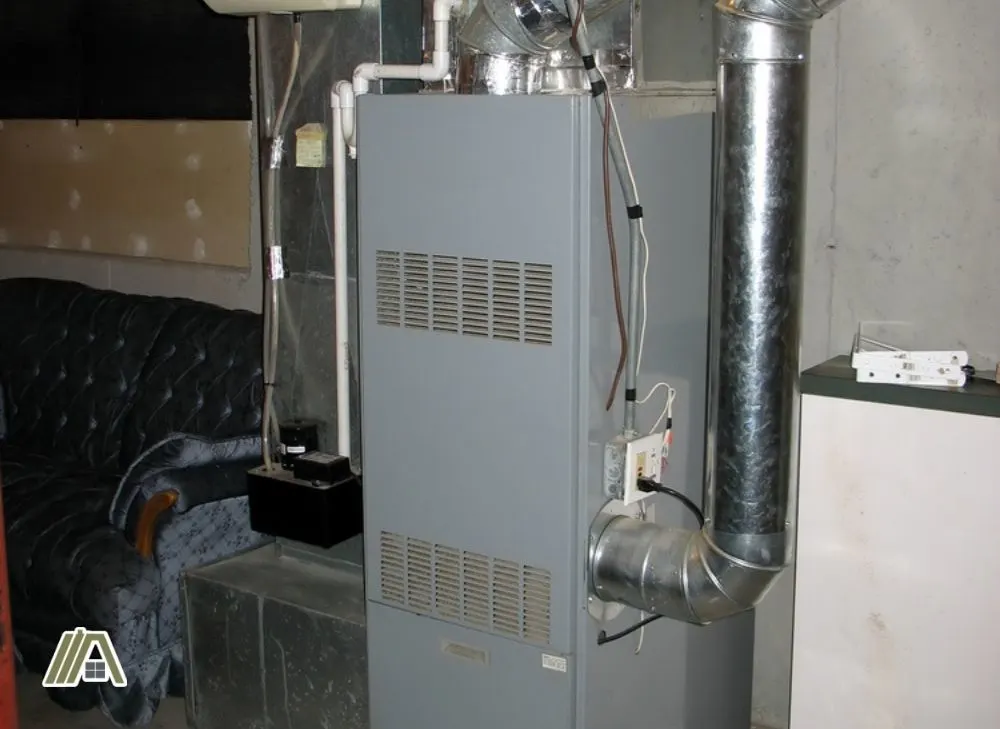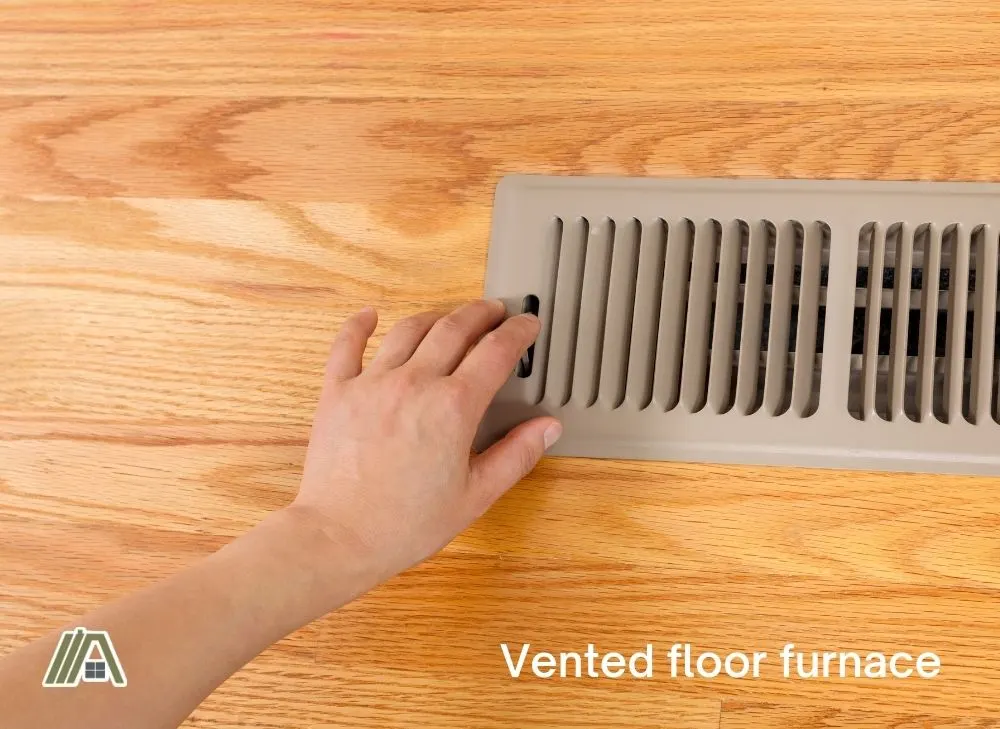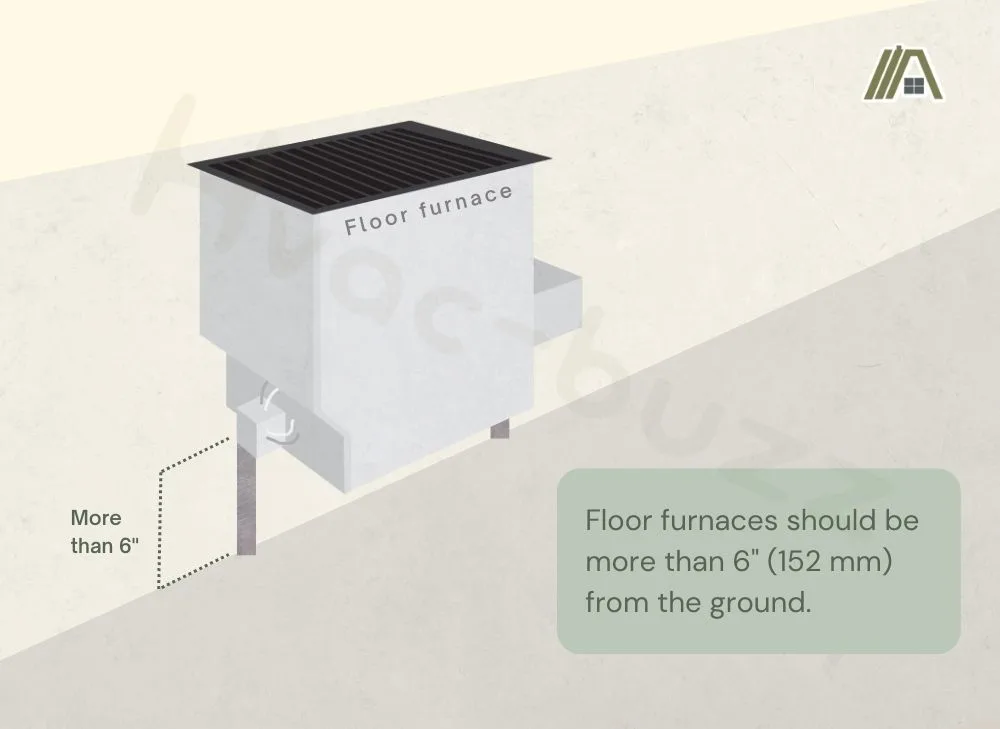A furnace is a crucial part of HVAC systems, so it is essential to know how to install one in your home. A major part of this is that the large heating appliance must be clear of certain materials to keep it safe. Now, if you are attempting to find the clearance “rules” for furnaces, you may be having some trouble.
The manufacturer’s knowledge takes precedence for clearances, which means the information is very scattered. I have done some research for you to give you a better idea of common furnace clearance practices across a few brands.

Furnace clearances differ slightly according to different manufacturers and the way the appliance is installed. Always check the individual instructions provided with the furnace. In general, there are relatively standard clearances or ranges across several furnace brands (0-6").
Why Are Clearances Important?
Fire Safety
Clearances are included in appliance manuals and the International Residential Code (IRC) because these are distances designed to keep you safe. Furnace clearances refer to the minimum distance that the appliance must be from any flammable materials.
Furnaces are appliances that generate heat, often by burning fuel. The heat and combustion involved in the operation mean the risk of fires around the machine is higher.

The manufacturer-determined clearances are the distances that are considered safe for combustible materials to be around the furnace. This helps prevent sudden ignition if heat builds up in the vicinity.
While there is risk associated with the appliance, if you follow the standards for safety, you can significantly decrease the chances. For example, provided you comply with the IRC regulations, you can safely install a furnace in a crawl space.
Accessibility
Part of keeping large household appliances safe, especially those generating large quantities of heat, is maintaining them.
To properly maintain your furnace, like all other appliances, you need enough room to clean, inspect, repair, and replace something on the appliance. This helps keep the furnace functioning optimally for longer, and decreases the likelihood of fires and breaking down.
For example, you need to be able to regularly inspect and clean or replace the filter on the furnace. This keeps dust away from the combustion site, which helps prevent the ignition of particles. This is also why the furnace intake must be clear of dryer vents.
These filters will fill up, and this will restrict airflow into the furnace. When not enough air can get in, this increases how hard the furnace works to pull air in and heat it, which can cause overheating as there is not enough air for the heat to spread through.
Additionally, Section M1305.1 of the IRC requires that no permanent constructions, other appliances, or any ducting connected to the appliance need to be removed to access an appliance.
What The IRC Says
The IRC, Section M1402.2, says that your central furnace clearances must follow its listing and installation instructions from the manufacturer.
There are so many different brands and models of appliances like furnaces that it would be inefficient to have each product listed in the IRC.
This is why the IRC relies on the safety and performance-based listing (or rating) codes provided by approved external organizations, mainly the Underwriters Laboratories (UL) and American National Standards Institute (ANSI).
| Central Furnace | Listing (Section M1402.1) |
| Oil-fired | UL 727 ANSI 727 |
| Electric | UL 1995 UL/CSA/ANCE 60335-2-40 |
You can also see the Canadian Standards Association (CSA) and the Association of Standardization and Certification (ANCE) mentioned in the IRC.
Vented floor furnaces are also required to be installed according to their listing and manufacturer instruction, as per Section M1408.2 of the IRC.
| Vented Floor Furnace | Listing |
| Oil-fired | UL 729 |

The manufacturers are the experts on their products. Therefore, provided the product is verified by the safety organizations, the IRC entrusts the best installation practice to the manufacturer’s knowledge.
Gas Furnaces
Many furnaces on the market are, in fact, gas-powered. Information on central-heating gas furnaces can be found in Section G2409.4 of the IRC, which might be more relevant to your search.
Gas furnace installation should also follow manufacturer clearance instructions, per Section G2309.4.1, although the IRC (Section G2409.4.5) specifies that sufficient servicing clearance is required.
This means that you need at least a 24″ clearance in front of the appliance to allow easy access for cleaning and servicing, which are important for gas appliance functionality.
Defining Central and Floor Vent Furnaces
Furnaces are the HVAC appliance that provides heated air to your home. However, different types of furnaces perform slightly differently.
Central furnaces are the kind involved in your central heating system. This kind of furnace distributes warm air to your whole house.
Floor furnaces are level to the ground floor of a house. They are generally stored in a small room and use the natural rising of heat to disperse warmth. These are more room specific than central furnaces and considered less effective.
Furnace Clearances
As I mentioned earlier, many different brands make furnaces. So, I will look at the most common clearances, or typical ranges, for several popular brands (as of 2022):
- Bryant
- Daikin
- Goodman
- Rheem
- Trane
For these clearance measurements, you will need to measure the distance between the combustible material surface and the appropriate face or fixture on the furnace unit.
Note: Please check the clearance instructions for the specific model you are looking at, as there is some variation despite frequent uniformity in the distances.
Wall Clearances
| Brand | Orientation | Minimum Side Clearance | **Minimum Front Clearance | Minimum Rear Clearance |
| Bryant | Vertical | 0-1” | 1-3” | 1” |
| Bryant | Horizontal | 0-1” | 1-3” | 1” |
| Daikin | Vertical | 0” | 3” | 0” |
| Daikin | Horizontal | 6” | 3” | 0” |
| Goodman | Vertical | 0-1” | 3” | 0” |
| Goodman | Horizontal | 6” | 3” | 0” |
| Rheem | Vertical | *0-4” | 3” | 0” |
| Rheem | Horizontal | *0-4” | 3” | 0” |
| Trane | Vertical | 0” | 3” | 0-1” |
| Trane | Horizontal | 0-1” | 3” | 1-6” |
**Minimum of 24” frontal clearance required for servicing. While the listed frontal clearances are the minimum for safety, most brands recommend installing the furnaces with the 24″ clearance required for servicing.
As you can see, there are general guidelines for the clearance around the furnace. This can help if you are trying to size a space before your shopping (or moving) begins.
The side clearances can be influenced by vent placement, but those particulars are contained in the installation manual for the individual models.
Floor Clearances
| Brand | Orientation | Minimum Bottom Clearance |
| Bryant | Vertical | 0” |
| Bryant | Horizontal | 0-1” |
| Daikin | Vertical | Not specified |
| Daikin | Horizontal | Not specified |
| Goodman | Vertical | Not specified |
| Goodman | Horizontal | Not specified |
| Rheem | Vertical | Not specified |
| Rheem | Horizontal | Not specified |
| Trane | Vertical | 0” |
| Trane | Horizontal | 0” |
Goodman and Daikin furnaces come with instructions regarding appropriate flooring materials instead of stating a floor clearance. Each series/appliance has instructions indicating if they can be installed on wood floors or may only be on non-combustible floors.
However, it is always safer to install a furnace on non-combustible flooring. Additionally, you should keep décor items like rugs a few feet from the appliance.
Floor furnaces must comply with the following location requirements, according to Section
M1408.3:
- It must be at least 6” from a wall.
- The furnace’s wall registers must be at least 6” from the adjoining wall at the inside corners.
- The furnace’s register must be at least 12” from doors (in any position), curtains or draperies, and other combustible materials and items.
- The register must also be at least 5’ below combustible materials.
- The burner assembly must not project onto the underfloor area of occupied space.
- It must not be installed on a graded concrete floor construction.
- It must not be installed where a door opens within 12” of the grille opening.
Section M1408.4 states that there must be an opening (at least 18” by 24”) or trap door (22” by 30” or bigger) providing access to the furnace. It is also important that you have sufficient space in the opening and passageways around the furnace to replace any part of the appliance.
The installation of a floor furnace is managed by the requirements in Section M1408.5 of the IRC:
- The furnace thermostat must be in the same room as the furnace register.
- It must be supported independently to the floor register.
- It must be at least 6” from the ground, or minimum 2” above ground when the lower 6” of the furnace are sealed against water.
- If installation requires excavation, this must extend 30” beyond the control side and 12” beyond the other sides. The excavation must also be sloped outward (and upward) from the base to the surrounding grade without exceeding 45° from the horizontal line.
- It must not be supported from the ground.

Ceiling Clearances
The ceiling clearance of a furnace is better known as a top clearance. This is measured from the top of the casing. The top clearance of a furnace can be influenced by installation orientation (like with Daikin and Goodman), and it can also be affected by where vents are on the appliance.
| Brand | Orientation | Minimum Top Clearance |
| Bryant | Vertical | 1” |
| Bryant | Horizontal | 1” |
| Daikin | Vertical | 1” |
| Daikin | Horizontal | 6” |
| Goodman | Vertical | 1” |
| Goodman | Horizontal | 6” |
| Rheem | Vertical | 1” |
| Rheem | Horizontal | 1” |
| Trane | Vertical | 1” |
| Trane | Horizontal | 1” |
As furnaces are not the prettiest of household appliances, you will be glad to know that enclosing them is possible, provided the enclosure meets the IRC requirements, and there are a number of ways to hide the furnace to make it look much better.
Sources
https://www.houzz.com/discussions/2434040/difference-in-furnace-and-central-heating
https://russellsac.com/why-you-should-replace-your-old-floor-furnace/
https://www.familyhandyman.com/article/best-furnace-brands/
https://www.denversbestheatingandacrepair.com/top-10-furnace-brands-of-2022/
https://homeinspectioninsider.com/furnace-brands-to-avoid/
https://www.homereference.net/furnace-air-flow-configuration/
https://s3.amazonaws.com/WebPartners/ProductDocuments/656E7BD0-B936-40D0-92D8-3FB427A6973F.pdf
https://s3.amazonaws.com/WebPartners/ProductDocuments/54A98673-30E3-45AA-947C-D964FC352885.pdf
https://www.manualslib.com/manual/457907/Bryant-355aav.html?page=5#manual
https://www.manualslib.com/manual/829346/Bryant-987ma.html?page=6#manual
https://www.questargas.com/ForEmployees/qgcOperationsTraining/Furnaces/Trane_TUH2_TDH2_AUH2_ADH2.pdf
https://www.riversideheatingandair.com/blog/2-dangerous-furnace-problems-and-how-to-prevent-them


